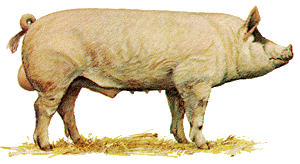I demand! Lean Pork Please…
A glimpse within the growth hormone regulation of protein metabolism in pigs.
By Victor Allen M. Anas, DVM
The increase in consumer demand for lean meat has stimulated the need for technologies to reduce fat and increase lean in meat animals. Swine experts in genetics, nutrition and physiology have employed their respective fields of technology to achieve the continuing goal of the swine industry to produce fast growing pigs and increase the quantity of high-quality lean carcass. Supplementing growth hormone an anabolic agent increases muscle mass in pigs, while also improving the rate and efficiency in growth were demonstrated by various studies. Growth Hormone (GH) also known as Somatotropin (ST) viewed as the master hormone that regulates growth and performance has been shown to have impressive effects on nutrient partitioning between muscle and adipose tissue that leads to dramatic alterations in the growth of the tissues.
GH has markedly influenced Protein metabolism. Generally, growth hormone stimulates protein anabolism in many tissues. This effect reflect increased amino acid uptake, increased protein synthesis and decreased oxidation of proteins. One of the most important ways that it affects protein metabolism is to increase retention of nitrogen by the body. The loss of nitrogen into the urine as urea or other nitrogenous waste products is diminished indicating retention within the body. In addition, another and possibly more important effect of GH is to increase cell permeability to amino acids thereby favoring a buildup of the muscle mass of the body. Evidence suggests that GH favors protein synthesis by gene activation, mRNA synthesis and ribosomal RNA and transfer RNA production by liver cell. Continue reading “Lean pork”

